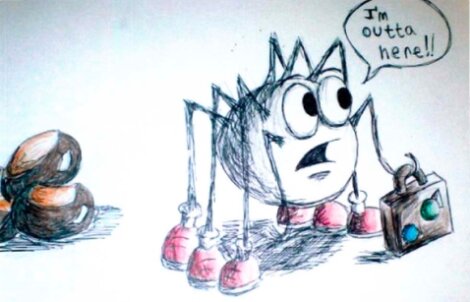Last year the RSC launched a huge public investigation into a matter of national importance: are spiders afraid of conkers? Here's all the evidence for and against, and the conclusion we came to
A national competition led to hundreds of letters, emails, photos and videos, and some more creepy things, being sent to the RSC, and we eventually ruled that the best evidence provided showed the old wives’ tale to be false.
This year has seen much activity in the spider/conker sphere, so I’m going to use this opportunity to lay out everything we considered, and our reasons for coming to the verdict that no, spiders are not afraid of conkers.
A short history of nearly everything (spiders- and conkers-related)
Several people in the RSC offices were passing around tips as another wet, warm British summer gave way to a wet, warm British autumn. The weather was perfect breeding conditions for house spiders, said the papers at the time, so many were complaining of the recent influx, and searching for a solution.
According to sources such as “my mum”, “my grandmother” and “the guy next door”, the most effective way of deterring autumnal arachnids was to strategically place fresh conkers (also known as horse chestnuts) around the home. The office rumour became more widespread and filtered its way through to the press office, whose first thought was, of course, “I wonder if there’s any chemistry in that?”
We wanted evidence, and set about collecting it the best way we knew how: to ask the public to help out. An incentive of £300 and intellectual satisfaction was more than enough to encourage floods of entries that were painstakingly analysed by yours truly.
There was plenty of pretty convincing evidence both ways, but the winning entry stood above the rest as a fabulous example of scientific curiosity, rigour and fair-mindedness. Here’s some from both sides of the argument.
The evidence in favour: tradition, science and desperation
Of those who contacted us with some form of evidence, most held the firm belief that this old chestnut of a trick works. Many of the believers cited ancestral approval as their main evidence, with generations of mothers and grandmothers swearing by the method, and several more had read/heard/seen about it in the media somewhere. Many devoted Togs quoted the sorely-missed Terry Wogan as their source. I don’t think Chris Evans has the first idea about spider repellents. Tsk.
Anyway, none of these anecdotal reports were strong enough for us. While the contributions were most welcome, and it was pleasing to see that people were actually thinking about the potential science behind it working, we couldn’t go on rumour and speculation, Wogan forgive me.
Another problem our intrepid home scientists faced was that capturing more convincing evidence on film was pretty tough. Spiders are normally quite shy, and training a 24-hour CCTV camera on a pile on conkers in your living room is likely to attract attention from your family and, in time, psychiatrists. This didn’t stop people giving it a shot though. We were sent hundreds of photos of… piles of conkers. Some entertaining, some quite absurd, and some better described as worrying. The slideshow below shows some of my favourites.
And we did even get videos. In fact the first submission was from an RSC staffer who used the classic “conker on a wooden spoon” tactic to bait spiders into either furiously attacking or running for the hills. The latter option was more apparent from the video, but it wasn’t really convincing:
Some other followers of the Way of the Conker had much better evidence. A couple pointed out that in the US, and probably elsewhere, you’ll see roofbeams in old churches and the like are made from aromatic woods such as sandalwood. This, I’m told, is because carpenters of yesteryear knew these sweet-smelling woods deterred all kinds of burrowing insects such as termites. A similar mechanism might be in play with spiders and conkers, they said. Interesting – let’s have more reasoned arguments.
Several correspondents pointed us towards household gadget catalogue Betterware (other household gadget catalogues are available), who were selling spider-repellent sprays and liquids that purported to be based on conkers. Some people wrote in to tell me it worked, others were saddened that it didn’t, and one kind soul sent me a coupon to get 50p off my first bottle.
A response to my blog post at the time really caught my interest. Cheryl Osborne had recently written a dissertation for an MA in Textile Conservation. As she wrote in the comments:
Some conkers had been found in an old trunk filled with ceremonial furs and costume and had seemingly protected the contents from attack. My research found many interesting anecdotal stories of a past custom to collect and distribute conkers in drawers and cupboards every autumn to protect contents from insect larva damage…
…The brown skin of the conker contains the triterpenoid saponin, which is a natural insect repellent. Horse chestnut extract is often used in products such as shampoo. The chemicals known as terpenes, are also found in essential oils such as lavender, widely used to repel insects.
Fascinating – proper chemistry here. Cheryl kindly sent me a copy of her dissertation, and that really had me convinced, quite close to the end of the competition, that it was going to be a win for the believers.
The evidence against: experiments good, bad and pretty ugly
Evidence that showed spiders to be indifferent to conkers was in the minority by numbers, but quality over quantity was my temporary motto. An interesting trend was that the older the respondent, the more likely it was to be in favour of the tale being true, and the younger ones tended to be more sceptical.
Let’s get some of the rubbish experiments out the way. I appeared on BBC Breakfast to talk about this story (at the crack of dawn on a Sunday, so I won’t show any pictures for fear of frightening those of a nervous disposition). Alongside me was someone eminently more qualified to discuss the subject: Stuart Hine, manager of the Natural History Museum’s Insect Identification Service. He brought to the studio, to my amusement and the interviewer’s slight panic, a couple of live spiders from his shed, some conkers, some gravel and a glass tank.
Twice we set up the experiment, with gravel on one side of the tank and conkers on the other, to see where the spider would go. Predictably, the spider sat quivering in the gravel corner for the first, and scuttled happily into the conker pile for the second. I think we proved that spiders aren’t keen on studio lights (and for that matter neither am I at 06:30 on a Sunday…)
Many of the best pieces of experimentation we received were from children, both inspired individuals and creative classes. Whole classes conducted fair and measured experiments, collecting and analysing results and drawing reasoned conclusions. It really was heartening to see how unbiased a young mind can be. Mostly involving live test subjects (humanely treated I might add), the experiments tended towards the “ring of conkers around a spider – does it crouch in fear or boldly scale the conkers to freedom” sort. Others introduced a choice: would the spider climb the rock wall or the conker wall?

The answer was apparently simple: in almost all cases the answer to the question “are spiders afraid of conkers” was a resounding “no”. Actually the kids were more astute than I give them credit for; most answers were a resounding “our experiments aren’t sufficient to draw a reasoned definite conclusion but our evidence would suggest that spiders don’t really mind conkers.” Not as pithy that way.
Winning entry: fair tests and fearless kids
When the competition’s deadline passed, I had powerful arguments both ways. I’d already found my favourite entry, though, and it was a deserving winner of our prize and a brilliant example of what made the younger entrants’ evidence so convincing.
Young budding scientists from years 5 and 6 at the Roselyon School in Cornwall had submitted, with a little help from their teacher Mr Ferguson, a fabulous five-minute documentary of several experiments leading them to a scientific conclusion.
I was mightily impressed with the rigour of the experiment design, and also the immunity to fear demonstrated by the children. They giggle through minor accidents like a spider escaping up someone’s sleeve, whereas at that age I would have, err, reacted differently.
Conclusion: inconclusive?
Well it’s all a bit of fun really isn’t it? I think a lot of people sat down and thought about the possible chemistry of conkers, which is a result for us. I discovered that triterpenoids are in conker skins and do repel moths. Our winners suggested that spiders aren’t really fussed by conkers with some pretty good experiments, though, and I reckon that trumps any guesswork. If you fervently believe otherwise I’d be delighted to hear from you.
Going back to spider expert Stuart from the Natural History Museum for a second: in response to the notion that spiders are more likely to be indoors after a wet summer he said “I don’t really think so. House spiders live in the house – they live and breed inside. It’s more likely that the people themselves are in the house more often when it’s wet, and are therefore around to see more of the spiders’ usual cross-carpet expeditions.”
So the problem isn’t even seasonal, but people are more concerned in the autumn – when conkers lie handily about. Perhaps that’s no coincidence.
But who knows what goes on in the minds of our eight-legged friends? There may be a chemical deterrent that sets them scuttling off. The jarringly white-coated people in department stores often spray unsettling chemical perfumes that deter me.
And if the presence of conkers soothes the nerves of arachnophobes around the country, where’s the harm for the rest of us? As one respondent said “I decorate my home with conker in autumn because they look nice and seasonal – any spider repelling qualities are a bonus.”
There’s the evidence. Absorb it, take what messages and you will, and decide for yourselves. We think the kids from Roselyon, and the many other children who sent in excellent experimental data, showed pretty well there’s not much of an argument for spiders disliking conkers. I’m just happy that so many people took so much time to help us. And that it prompted someone to submit this picture.
